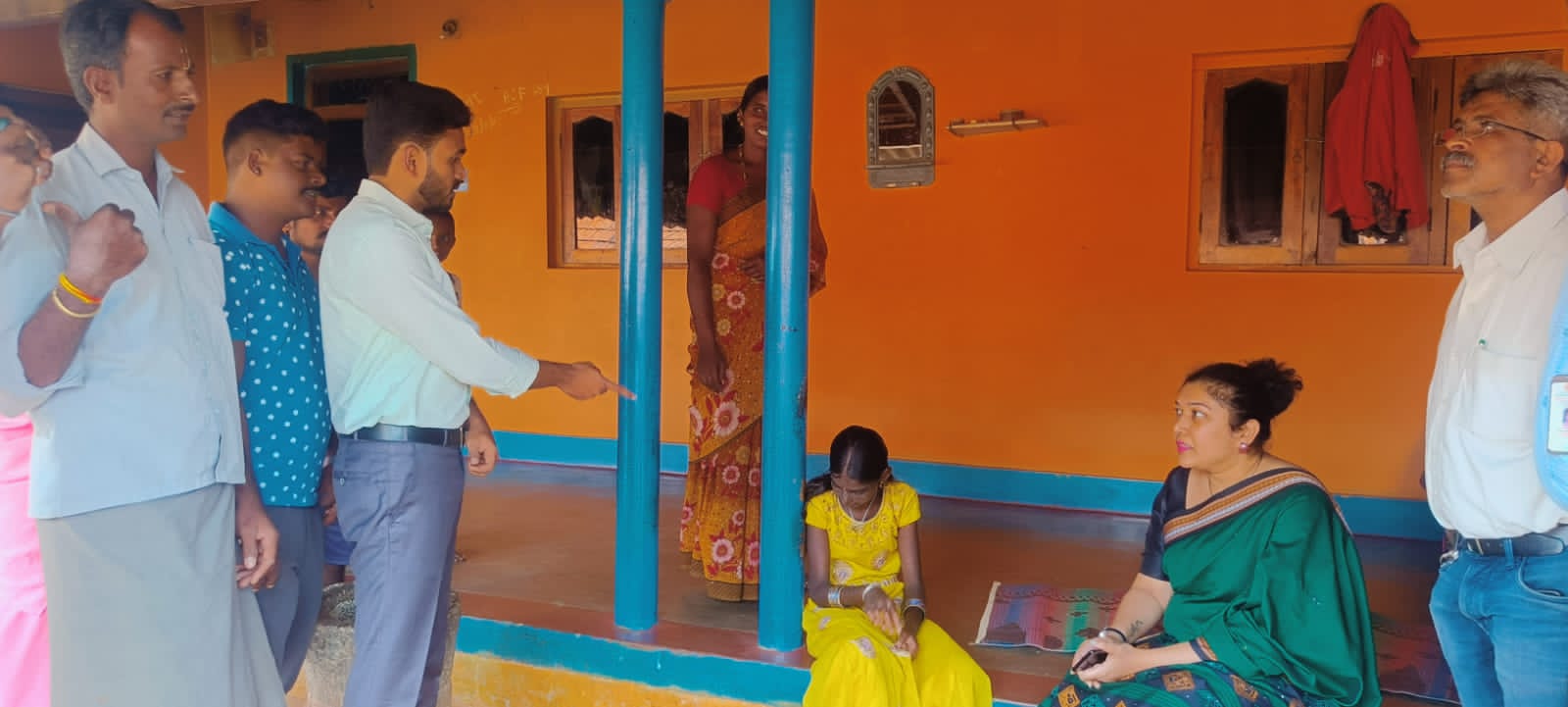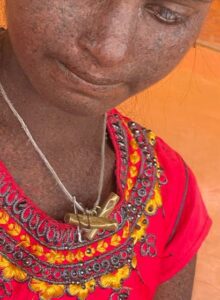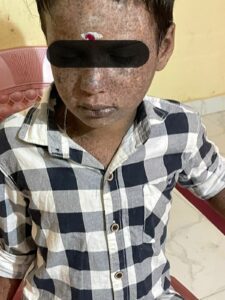Genetic counsellor from Mysuru prepared action plan, budget to address Xeroderma Pigmentosum in three villages of Chamarjanagar.

Action plan prepared for Chamarajanagar's 'children of darkness' (DC)
In a significant step towards addressing the distressing issue of children succumbing to the rare genetic disorder Xeroderma Pigmentosum (XP), the Karnataka government has swung into action.
Following a comprehensive investigation by South First, shedding light on the deaths of children due to XP in three villages, the state authorities have embarked on a mission to tackle this pressing concern.

Savitha outside her residence (Chetana Belagere)
XP, a rare genetic disorder, renders its victims highly susceptible to the harmful effects of ultraviolet (UV) radiation from sunlight.
This condition is predominantly inherited through autosomal recessive genes from both parents, impairing the DNA repair mechanisms that shield the body from UV-induced damage.
Individuals with XP exhibit a range of symptoms including severe sunburn, freckle-like pigmentation, dry and scaly skin, eye problems, and even neurological issues in some cases.
Compounding the issue, those affected by XP are at an elevated risk of developing various skin cancers, necessitating immediate and effective intervention.
In the three villages of Chamarajanagar district in Karnataka, namely Kuratti Hosur, Shettihalli and Bhadrenahalli, nearly 15 children have suffered this condition with only five of them alive now, still battling this rare genetic condition.
In response to the gravity of the situation, the Karnataka government has demonstrated its commitment by actively engaging with experts in the field, local families, and medical professionals.
“After reading the series in South First, on the instructions from the health minister and our commissioner and also chief minister’s office, health department officials along with the District Commissioner of Chamarajanagar and medical officers visited all the affected families from these villages,” said Nodal Health Officer Dr Chandrashekar P.
“We have so far done a detailed medical check of these children and have done their family tree too to know the source of the disease,” he added.
During their visit to the affected villages, government officials met with families and held discussions with Dr Deepa Bhat, a renowned Genetic Counselor from JSS Medical College and Hospital, who’s aware of the condition of these children.
She had spoken to South First in detail on how the government could intervene in this issue to ensure the genetic disease was prevented in the community.
ಚಾಮರಾಜನಗರ ಜಿಲ್ಲೆ ಹನೂರು ತಾಲೂಕಿನಲ್ಲಿ ಮಕ್ಕಳಿಗೆ ಕೈ ಕಾಲು ಮುಖದ ಮೇಲೆ ಕಪ್ಪು ಬಿಳಿ ಚುಕ್ಕೆಗಳು ಕಾಣಿಸಿಕೊಂಡ ಹಿನ್ನೆಲೆ ವೈದ್ಯಾಧಿಕಾರಿಗಳೊಂದಿಗೆ ಮಕ್ಕಳ ಮನೆಗಳಿಗೆ ಭೇಟಿ ನೀಡಿ, ಅಗತ್ಯ ವೈದ್ಯಕೀಯ ಸೇವೆ ಹಾಗೂ ಆತಂಕಗೊಂಡಿದ್ದ ಪೋಷಕರಲ್ಲಿ ಧೈರ್ಯ ತುಂಬಲಾಯಿತು. #Hanur #Chamarajanagar @CMofKarnataka @KarnatakaVarthe pic.twitter.com/qEqYEjb96x
— DC Chamarajanagar – ಜಿಲ್ಲಾಧಿಕಾರಿ ಚಾಮರಾಜನಗರ (@dcchnagar) July 29, 2023
Dr. Bhat, armed with her expertise and knowledge, has meticulously formulated a multi-phase action plan aimed at managing and mitigating the impact of XP within the afflicted population, a copy of which is with South First.
This exhaustive plan, submitted to the government for implementation, encompasses various stages:
Phase 1: Identification, Screening, and Initial Management
The first phase involves educating the community about the disease, its preventive measures, and the available treatment options. A team of dermatologists, ophthalmologists, and genetic counselors will conduct comprehensive screenings to identify individuals with manifestations of XP.
This phase also includes regular check-ups, provision of protective clothing and accessories, as well as the surveillance of cancer signs.

Seven year old Naveen who is currently in Bengaluru loves to read and write. (Chetana Belagere/South First)
Phase 2: Genetic Testing and Evaluation
The second phase revolves around genetic testing to identify carriers and affected individuals. Collaborating with specialised labs, the plan encompasses sample collection, DNA extraction, and thorough genetic evaluation.
This phase will enable the development of a deeper understanding of the genetic factors contributing to XP within the population.
Phase 3: Genetic Counseling and Future Prevention
Genetic counseling and follow-up form the crux of the third phase. Families will be provided with comprehensive information about their genetic status and risks.
Couples planning to start a family will receive guidance on preventing the inheritance of XP in future pregnancies.
This includes testing spouses for mutations and conducting antenatal testing for the foetus, all in compliance with Pre-Conception and Pre-Natal Diagnostic Techniques (PCPNDT) Act, 1994.
Dr Deepa Bhat, the architect behind this extensive action plan, shared, “This initiative is a significant stride towards addressing the challenges posed by Xeroderma Pigmentosum.”
“The combined efforts of the Karnataka government, medical professionals, and affected families will play a pivotal role in reducing the impact of this disorder,” she added.
The Karnataka government has expressed its commitment to implementing Dr Bhat’s action plan, ensuring that the affected villages of Kuratti Hosuru and Bhadrenahalli, along with the wider population of Chamarajanagar, receive the much-needed support and medical attention.
“We will submit the report to the district collector’s office and also to our health department and take a decision soon on this,” said Dr Chandrashekar P, Chamarajanagar District Leoprosy Officer and Nodal Officer for Hanur who has been working closely with the villagers to follow up on this issue.
A detailed budget estimate for the genetic evaluation of the Kuratti Hosuru, Bhadrenahalli and other population of Chamarajanagar suspected to be affected with Xeroderma Pigmentosum and other genetic disorders has also been done.
While the authorities have to go through the budget details, Health Minister Dinesh Gundurao had assured South First that the health department would look into it closely and ensure that they got whatever needed to be done to stop this disease in the villages.
“We will do our best to ensure that intervention happens in the villages. Also, the affected families are given some monetary help for the management of this condition,” said Dinesh Gundurao.
The budgeting also involves camps for family mapping, pedigree analysis, choosing one member in the family as an index case for clinical exome sequencing, in all of these villages.
“Clinical exome sequencing has to be done for one affected member of the family first. Remaining members of the family shall be tested for the genetic variant identified from above clinical exome sequencing,” explained Dr Deepa Bhat.
Antenatal testing, by amniocentesis, for the pregnant mothers from the 16th week is also included in the budget.
Dr Bhat has made a list of necessary things for those affected people.
It includes: UV protective jackets, sunscreen lotion with SPF 50 or more (At least four 50 gm tubes per month) to be applied whenever stepping outside, UV protective glasses, biennial evaluation by Ophthalmologist, Dermatologist & Oncologist.

May 10, 2024

May 09, 2024

May 09, 2024

May 09, 2024

May 09, 2024

May 09, 2024